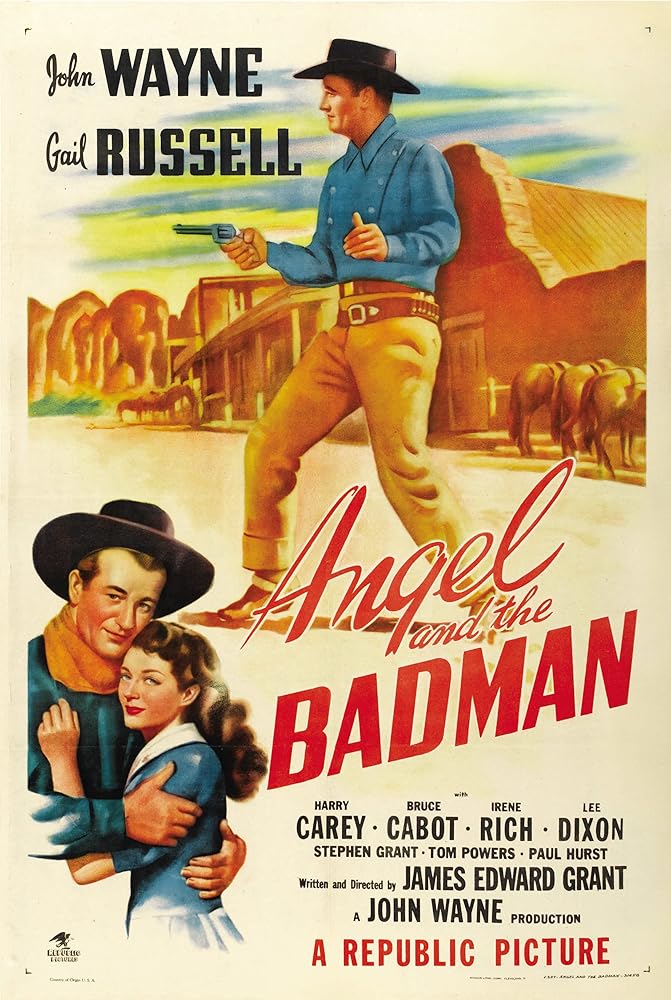
ANGEL AND THE BADMAN, THE
(director/writer: James Edward Grant; cinematographer: Archie J. Stout; editor: Harry Keller; music: Richard Hageman; cast: John Wayne (Quirt Evans), Gail Russell (Penelope Worth), Harry Carey (Territorial Marshal Wistful McClintock), Bruce Cabot (Laredo Stevens), Irene Rich (Mrs. Worth), Lee Dixon (Randy McCall), Stephen Grant (Johnny Worth), Tom Powers (Dr. Mangram), Paul Hurst (Frederick Carson, Worth’s neighbor), Olin Howlin (Bradley, town telegrapher), John Halloran (Thomas Worth), Marshall Reed (Nelson), Joan Barton (Lila Neal), Louis Faust (Hondo); Runtime: 100; MPAA Rating: NR; producer: John Wayne; Republic; 1947)
“Genteel Western.“
Reviewed by Dennis Schwartz
This was the first film produced by John Wayne, where he’s now the tall man in the saddle for Republic. Wayne’s regular writer James Edward Grant also gets a chance to direct this time around, something Wayne never allowed him to do again after the film bombed in the box-office.
John Wayne’s genteel Western has him as Quirt Evans, a notorious gunslinger who converts and throws away his guns for the love of angelic Quaker girl Penelope Worth (Gail Russell). Instead of action-packed sequences Wayne and company do a lot of sermonizing over the Quaker belief that “All men are good if shown the light.”
A wounded Quirt is nursed back to health in the Quaker farm home of Thomas Worth and his wife, and their young impressionable son John and their beautiful daughter Penelope. She falls in love with the badman and shuns her timid farrier Quaker suitor Nelson, but Quirt feels she’d be better off being with her fellow Quaker and rejoins his crony Randy McCall in going after enemy outlaw Laredo Stevens (he murdered his kindly foster father in a rigged gun duel). Back in town with bar girl Lila, Quirt yearns for the sweet and kindly Penelope. So he purposely gets into a comical barroom brawl that wasn’t funny and the fighting sequences weren’t all that well constructed. After the brawl Quirt goes back to boarder again with the always friendly Worths, who might very well be the most unreal goody-goodies to ever appear in a Western (they seemed to be from another planet speechifying that “No one can hurt you but you yourself”). Quirt’s last temptation with gunplay comes when he rustles cattle from Laredo, which is his way of getting the money owed him by Laredo for a land deed sold. Laredo strikes back by injuring Penelope and almost killing Quirt while he’s unarmed in a horse buggy. The typical Western shootout is set in town outside the saloon, as Quirt calls out Laredo and his henchman Hondo seeking revenge just as the Worth family arrives. Quirt must choose the way of the gun or the love of a religious woman who doesn’t believe in violence. The contrived ending makes sure things go as orchestrated as the folksy marshal (Harry Carey) settles things in his own way, showing a partiality to Quirt over the other two characters.
It’s evocative of a few silents made by John Ford and Harry Carey. In 1956 Friendly Persuasion copied Angel’s thematic dilemma – whether to take up weapons or not – and was able to have better commercial success with an even less of a quality film.
REVIEWED ON 6/1/2005 GRADE: C+